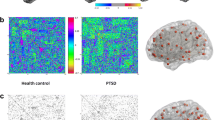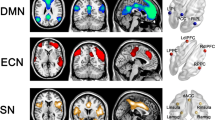Abstract
The topological properties of functional brain networks in post-traumatic stress disorder (PTSD) have been thoroughly examined, whereas the topology of structural covariance networks has been researched much less. Based on graph theoretical approaches, we investigated the topological architecture of structural covariance networks among PTSD, trauma-exposed controls (TEC), and healthy controls (HC) by constructing covariance networks driven by inter-regional correlations of cortical thickness. Structural magnetic resonance imaging (sMRI) scans and clinical scales were performed on 27 PTSD, 33 TEC, and 29 HC subjects. Group-level structural covariance networks were established using pearson correlations of cortical thickness between 68 brain areas, and the graph theory method was utilized to study the global and nodal properties. PTSD and HC subjects did not differ at the global level. When PTSD subjects were compared to TEC subjects, they had significantly higher clustering coefficient (p = .014) and local efficiency (p = .031). Nodes having different nodal centralities between groups did not pass the false-discovery rate correction at the node level. According to the structural brain network topological characteristics discovered in this study, PTSD manifests differently compared to the TEC group. In the PTSD group, the SCN keeps the small-world characteristics, but the degree of functional separation is enhanced. The TEC group’s reduced small worldness and the tendency for brain network randomization could be signs of trauma recovery.




Similar content being viewed by others
Availability of data and material
Not applicable.
Code Availability
Not applicable.
References
Achard, S., & Bullmore, E. (2007). Efficiency and Cost of Economical Brain Functional Networks. PLOS Computational Biology, 3(2), e17
Achard, S., Salvador, R., Whitcher, B., Suckling, J., & Bullmore, E. (2006). A resilient, low-frequency, small-world human brain functional network with highly connected association cortical hubs. J Neurosci, 26(1), 63–72. https://doi.org/10.1523/JNEUROSCI.3874-05.2006
Admon, R., Milad, M. R., & Hendler, T. (2013). A causal model of post-traumatic stress disorder: disentangling predisposed from acquired neural abnormalities. Trends Cogn Sci, 17(7), 337–347. https://doi.org/10.1016/j.tics.2013.05.005
Brust, M. R., Turgut, D., Ribeiro, C., & Kaiser, M. (2012). Is the clustering coefficient a measure for fault tolerance in wireless sensor networks? Communications (ICC), 2012 IEEE International Conference on
Bullmore, E., & Sporns, O. (2009). Complex brain networks: Graph theoretical analysis of structural and functional systems (Nature Reviews Neuroscience (2009) 10, (186–198)). Nature reviews Neuroscience, 10, 186–198
Cai, S., Wang, X., Yang, F., Chen, D., & Huang, L. (2021). Differences in Brain Structural Covariance Network Characteristics in Children and Adults With Autism Spectrum Disorder.Autism Research(1)
Chen, H. J., Qi, R., Ke, J., Qiu, J., Xu, Q., Zhong, Y. … Chen, F. (2020). Evaluation of gray matter reduction in patients with typhoon-related posttraumatic stress disorder using causal network analysis of structural MRI. Psychol Med, 1–10. https://doi.org/10.1017/S0033291720003281
Dale, A. M., Fischl, B., & Sereno, M. I. (1999). Cortical surface-based analysis. I. Segmentation and surface reconstruction. Neuroimage, 9(2), 179–194. https://doi.org/10.1006/nimg.1998.0395
Du, M. Y., Liao, W., Lui, S., Huang, X. Q., Li, F., Kuang, W. H. … Gong, Q. Y. (2015). Altered functional connectivity in the brain default-mode network of earthquake survivors persists after 2 years despite recovery from anxiety symptoms. Soc Cogn Affect Neurosci, 10(11), 1497–1505. https://doi.org/10.1093/scan/nsv040
Fischl, B., Sereno, M. I., & Dale, A. M. (1999). Cortical surface-based analysis. II: Inflation, flattening, and a surface-based coordinate system. Neuroimage, 9(2), 195–207. https://doi.org/10.1006/nimg.1998.0396
Francesmonneris, A., Pincus, H., & First, M. (2013). Diagnostic and Statistical Manual of Mental Disorders: DSM-V. American Psychiatric Association
Freeman, L. C. (1977). A Set of Measures of Centrality Based on Betweenness. Sociometry, 40(1), 35–41
Geuze, E., Westenberg, H., Heinecke, A., Kloet, C., Goebel, R., & Vermetten, E. (2008). Thinner prefrontal cortex in veterans with posttraumatic stress disorder. Neuroimage, 41(3), 675–681
Gong, G., Yong, H., Chen, Z. J., & Evans, A. C. (2012). Convergence and divergence of thickness correlations with diffusion connections across the human cerebral cortex. Neuroimage, 59(2), 1239–1248
Guo, T., Guan, X., Zeng, Q., Xuan, M., Gu, Q., Huang, P. … Zhang, M. (2018). Alterations of Brain Structural Network in Parkinson’s Disease With and Without Rapid Eye Movement Sleep Behavior Disorder. Front Neurol, 9, 334. https://doi.org/10.3389/fneur.2018.00334
Harnett, N. G., Stevens, J. S., Fani, N., van Rooij, S. J. H., Ely, T. D., Michopoulos, V. … Ressler, K. J. (2020). Acute Posttraumatic Symptoms Are Associated With Multimodal Neuroimaging Structural Covariance Patterns: A Possible Role for the Neural Substrates of Visual Processing in Posttraumatic Stress Disorder. Biol Psychiatry Cogn Neurosci Neuroimaging. https://doi.org/10.1016/j.bpsc.2020.07.019
He, Y., Chen, Z. J., & Evans, A. C. (2007). Small-world anatomical networks in the human brain revealed by cortical thickness from MRI.Cerebral Cortex(10),2407–2419
Huang, Y., Wang, Y., & Wang, H. (2019). Prevalence of mental disorders in China: a cross-sectional epidemiological study (vol 6, pg 211, 2019). Lancet Psychiatry, 6(4), E11-E11. https://doi.org/10.1016/S2215-0366(19)30074-4
Jeong, H., Chung, Y. A., Ma, J., Kim, J., Hong, G., Jin, K. O. … Yoon, S. (2019). Diverging roles of the anterior insula in trauma-exposed individuals vulnerable or resilient to posttraumatic stress disorder. Scientific Reports
Jeong, H., Lee, Y. J., Kim, N., Jeon, S., Jun, J. Y., Yoo, S. Y. … Kim, S. J. (2021). Increased medial prefrontal cortical thickness and resilience to traumatic experiences in North Korean refugees. Sci Rep, 11(1), 14910. https://doi.org/10.1038/s41598-021-94452-6
King, A. P., Abelson, J. L., Britton, J. C., Phan, K. L., Taylor, S. F., & Liberzon, I. (2009). Medial prefrontal cortex and right insula activity predict plasma ACTH response to trauma recall. Neuroimage, 47(3), 872–880. https://doi.org/10.1016/j.neuroimage.2009.05.088
Lei, D., Li, K., Li, L., Chen, F., Huang, X., Lui, S. … Gong, Q. (2015). Disrupted Functional Brain Connectome in Patients with Posttraumatic Stress Disorder. Radiology, 276(3), 818–827. https://doi.org/10.1148/radiol.15141700
Lynall, M. E., Bassett, D. S., Kerwin, R., McKenna, P. J., Kitzbichler, M., Muller, U., & Bullmore, E. (2010). Functional connectivity and brain networks in schizophrenia. J Neurosci, 30(28), 9477–9487. https://doi.org/10.1523/JNEUROSCI.0333-10.2010
Niu, R., Du, L., Chen, F., Chen, Y., Suo, X., Li, L. … Gong, Q. (2018). Reduced local segregation of single-subject gray matter networks in adult PTSD.Human Brain Mapping, 39
Niu, R., Lei, D., Chen, F., Chen, Y., Suo, X., Li, L. … Gong, Q. (2018). Disrupted grey matter network morphology in pediatric posttraumatic stress disorder. Neuroimage Clin, 18, 943–951. https://doi.org/10.1016/j.nicl.2018.03.030
Proessl, F., Dretsch, M. N., Connaboy, C., Lovalekar, M., Dunn-Lewis, C., Canino, M. C. … Flanagan, S. D. (2020). Structural Connectome Disruptions in Military Personnel with Mild Traumatic Brain Injury and Post-Traumatic Stress Disorder. J Neurotrauma, 37(19), 2102–2112. https://doi.org/10.1089/neu.2020.6999
Qi, S., Mu, Y. F., Cui, L. B., Zhang, J., Guo, F., Tan, Q. R. … Zhang, N. Y. (2017). Anomalous gray matter structural networks in recent onset post-traumatic stress disorder. Brain Imaging & Behavior
Ross, M. C., Sartin-Tarm, A. S., Letkiewicz, A. M., Crombie, K. M., & Cisler, J. M. (2021). Distinct cortical thickness correlates of early life trauma exposure and posttraumatic stress disorder are shared among adolescent and adult females with interpersonal violence exposure. Neuropsychopharmacology, 46(4), 741–749. https://doi.org/10.1038/s41386-020-00918-y
Rubinov, M., & Sporns, O. (2010). Complex network measures of brain connectivity: uses and interpretations. Neuroimage, 52(3), 1059–1069
Sanabria-Diaz, G., Melie-Garcia, L., Draganski, B., Demonet, J. F., & Kherif, F. (2021). Apolipoprotein E4 effects on topological brain network organization in mild cognitive impairment. Sci Rep, 11(1), 845. https://doi.org/10.1038/s41598-020-80909-7
Sporns, O., & Zwi, J. D. (2004). The small world of the cerebral cortex. Neuroinformatics, 2(2), 145–162
Stark, E. A., Parsons, C. E., Van Hartevelt, T. J., Charquero-Ballester, M., McManners, H., Ehlers, A. … Kringelbach, M. L. (2015). Post-traumatic stress influences the brain even in the absence of symptoms: A systematic, quantitative meta-analysis of neuroimaging studies. Neurosci Biobehav Rev, 56, 207–221. https://doi.org/10.1016/j.neubiorev.2015.07.007
Sun, D., Haswell, C. C., Morey, R. A., & De Bellis, M. D. (2019). Brain structural covariance network centrality in maltreated youth with PTSD and in maltreated youth resilient to PTSD. Dev Psychopathol, 31(2), 557–571. https://doi.org/10.1017/s0954579418000093
Suo, X., Lei, D., Li, K., Chen, F., Li, F., Li, L. … Gong, Q. (2015). Disrupted brain network topology in pediatric posttraumatic stress disorder: A resting-state fMRI study. Hum Brain Mapp, 36(9), 3677–3686. https://doi.org/10.1002/hbm.22871
Suo, X., Lei, D., Li, W., Chen, F., Niu, R., Kuang, W. … Gong, Q. (2019). Large-scale white matter network reorganization in posttraumatic stress disorder. Hum Brain Mapp, 40(16), 4801–4812. https://doi.org/10.1002/hbm.24738
Tijms, B. M., Series, P., Willshaw, D. J., & Lawrie, S. M. (2012). Similarity-based extraction of individual networks from gray matter MRI scans. Cereb Cortex, 22(7), 1530–1541. https://doi.org/10.1093/cercor/bhr221
Watts, D. J., & Strogatz, S. H. (1998). Collective dynamics of ‘small-world’ networks.Nature
Weathers, F. W., Keane, T. M., & Davidson, J. R. (2001). Clinician-administered PTSD scale: a review of the first ten years of research. Depress Anxiety, 13(3), 132–156. https://doi.org/10.1002/da.1029
Weathers, F. W., Litz, B. T., Herman, D. S., Huska, J. A., & Keane, T. M. (1993). The PTSD Checklist (PCL): Reliability, validity, and diagnostic utility.
Weiss, D. S. (2007). The Impact of Event Scale: Revised. In J. P. Wilson, & C. S. Tang (Eds.), Cross-Cultural Assessment of Psychological Trauma and PTSD (pp. 219–238). Springer US. https://doi.org/10.1007/978-0-387-70990-1_10
Zhang, J., Wang, J., Wu, Q., Kuang, W., Huang, X., He, Y., & Gong, Q. (2011). Disrupted Brain Connectivity Networks in Drug-Naive, First-Episode Major Depressive Disorder. Biological Psychiatry, 70(4), 334–342
Zhang, J., Chen, Y. H., Rosa-Neto, P., Germann, J., & Evans, A. C. (2008). Revealing Modular Architecture of Human Brain Structural Networks by Using Cortical Thickness from MRI. Cerebral Cortex, 18(10), 2374–2381
Zhu, H., Li, Y., Yuan, M., Ren, Z., Yuan, C., Meng, Y. … Zhang, W. (2019). Increased functional segregation of brain network associated with symptomatology and sustained attention in chronic post-traumatic stress disorder. J Affect Disord, 247, 183–191. https://doi.org/10.1016/j.jad.2019.01.012
Zung, W. W. (1965). A Self-Rating Depression Scale. Arch Gen Psychiatry, 12, 63–70. https://doi.org/10.1001/archpsyc.1965.01720310065008
Zung, W. W. (1971). A rating instrument for anxiety disorders. Psychosomatics, 12(6), 371–379. https://doi.org/10.1016/S0033-3182(71)71479-0
Acknowledgements
This study was supported by the National Natural Science Foundation of China (81871344, 81971602, 81760308), the Natural Science Foundation of Jiangsu Province (BK20191369), the Qing Lan project of higher education institutions of Jiangsu Province; This project was supported by Hainan Province Clinical Medical Center.
Funding
Not applicable.
Author information
Authors and Affiliations
Contributions
Author contributions included conception and study design (YZ and GML), data acquisition (FC and LZ), data processing and statistical analysis (TTX, JK, and RFQ), interpretation of results (TTX, FC, and YZ), drafting the manuscript work or revising it critically for important intellectual content (TTX, FC, YLD, and YZ) and approval of the final version to be published and agreement to be accountable for the integrity and accuracy of all aspects of the work (All authors).
Corresponding author
Ethics declarations
Conflict of interest
The authors have no conflict of interest to declare.
Ethics approval
According to the Declaration of Helsinki, all participants signed written informed consent. At the same time, a protocol, which has been approved by the ethics committee of Hainan General Hospital, was obtained for all subjects.
Consent to participate
Informed consent was obtained from all patients for being included in the study.
Consent for publication
All authors agree to publish this manuscript which has been read by all of them.
Additional information
Publisher’s note
Springer Nature remains neutral with regard to jurisdictional claims in published maps and institutional affiliations.
Tongtong Xu and Feng Chen contributed equally to this work and should be considered co-first authors.
Electronic supplementary material
Below is the link to the electronic supplementary material.
Rights and permissions
About this article
Cite this article
Xu, T., Chen, F., Zhang, L. et al. Study on the changes of Structural Covariance Network in post-traumatic stress disorder. Brain Imaging and Behavior 16, 1992–2000 (2022). https://doi.org/10.1007/s11682-022-00669-y
Received:
Revised:
Accepted:
Published:
Issue Date:
DOI: https://doi.org/10.1007/s11682-022-00669-y




